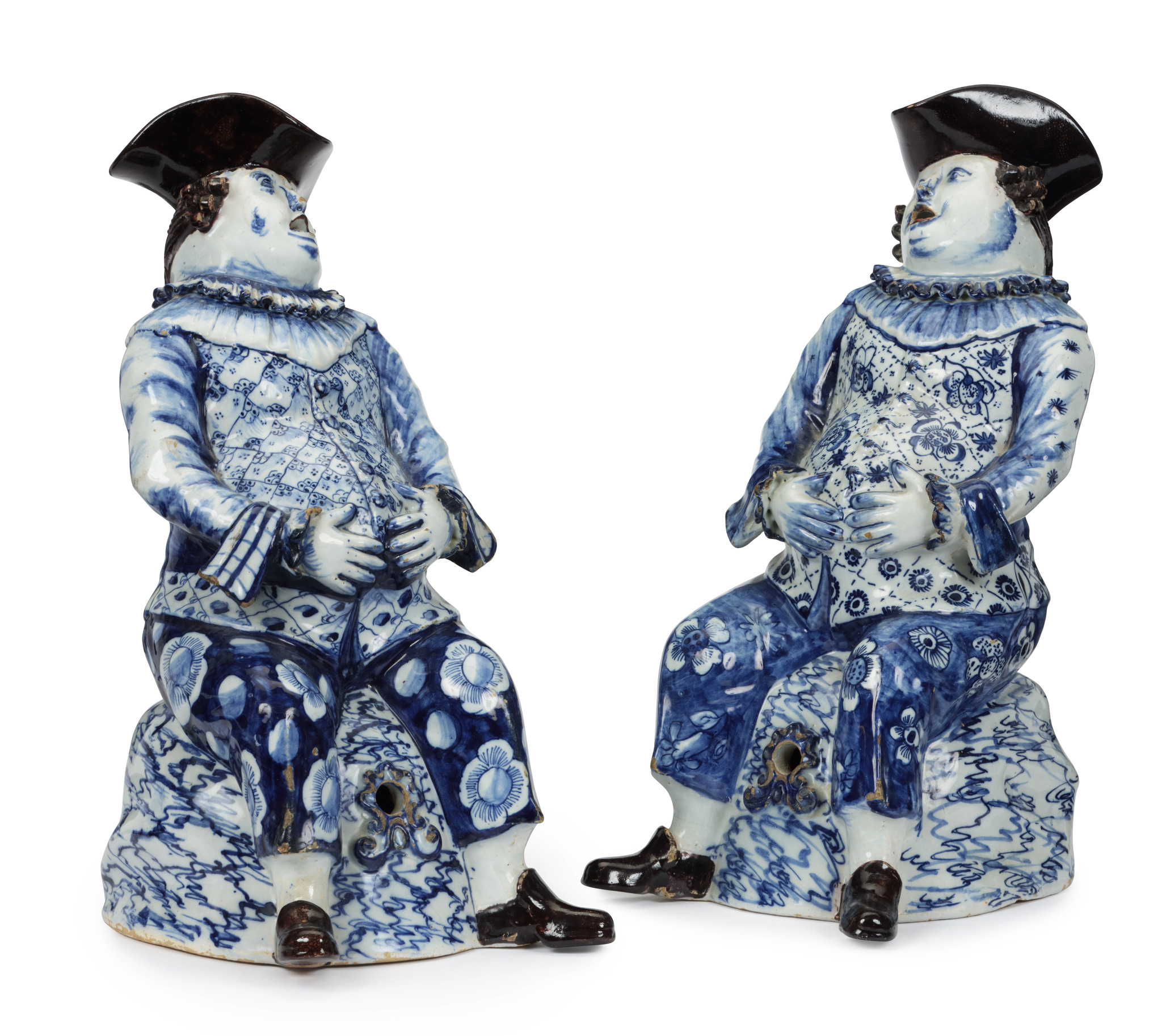
Drinking in Delft: Delft Drinking Vessels as Social Status Symbols
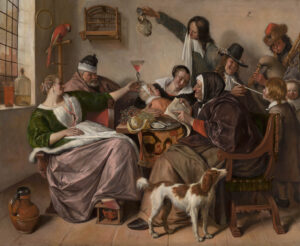
The Dutch drinking culture has a special relationship with Delftware. In this article, we explore how the pottery industry in Delft, influenced by these drinking traditions, has contributed to shaping the national identity.
The Netherlands has few freshwater streams, and for centuries, it was not safe to drink water unless it was boiled or collected from rain barrels. With limited alternatives available, beer emerged as the predominant safe beverage.(1) Brewing was one of the earliest industries, possibly only preceded by pottery making, which began as a domestic pastime before evolving into a commercial enterprise.(2) Key factors in the success of the brewing industry in the Netherlands included easy access to ingredients such as hops. A vibrant foreign trade supplied these essential ingredients but also boosted the demand for beer, because beer with hops was the only liquid that withstood long trade missions oversea.(3)
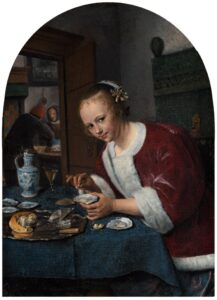
c. 1658-1660, Mauritshuis, Den Haag, inv. nr 818
Delft had one of the three most important brewing industries in the Northern Netherlands during the late medieval period, alongside Haarlem and Gouda.(4) In addition to brewing, Delft thrived in the textile industry, but this industry caused significant water pollution, endangering the brewing sector. However, strict waste regulations enacted in 1460 and later reinforced and extended(5), allowed the brewing industry in Delft to access relatively clean water. Despite these regulations, the quality of beer brewed in Delft declined around 1600.(6)
The rapid expansion of Rotterdam as a port and trading city led to a growing population, which increased the demand for beer.(7) This, combined with the decline in the quality of Delft beer, resulted in Rotterdam becoming the largest brewing city after Amsterdam. As the brewing industry waned, Delft sought new avenues for prosperity. While attempts to attract more textile businesses failed, the burgeoning pottery industry emerged as an ideal alternative.(8) Abandoned brewing factories along the waterfront proved perfect for Delftware factories. The large facilities allowed for growth, and access to water was essential for working with clay and transporting raw and finished materials.(9) Examples of pottery factories that were built on former brewery sites are ‘De Grieksche A’ (The Greek A), ‘De Witte Ster’ (The White Star), and ‘De Metaale Pot’ (The Metal Pot). It is unknown whether potters were actively approached or encouraged to settle in former breweries in Delft.(10)
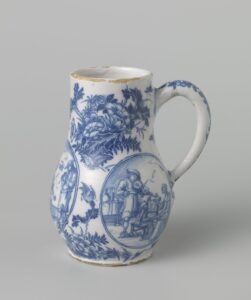
Beyond this practical connection between the brewery and pottery industries in Delft, the relationship with drinking further developed: namely, the production of Delft faience drinking vessels for alcoholic beverages.
After achieving independence, Northern Netherlands entered a Golden Age marked by great wealth and prosperity in the seventeenth century. Despite this, a strong sense of national unity had yet to form. The era was characterized by significant societal shifts, political changes, increased wealth, and evolving world views, all of which contributed to a dynamic sense of identity. Drinking played a significant role in Dutch culture, serving as both a mirror and a shaper of identities—ethnicity, gender, social status, and a collective national identity.(11) In fact, alcoholic consumption seemed crucial for hospitality and community bonding, making it a key activity in expressing emerging identities, connections and the growing Dutch national awareness.(12) The act of drinking, along with the vessels used, fostered rituals of sociability and inclusion, expressed regional pride, and made political and religious statements.
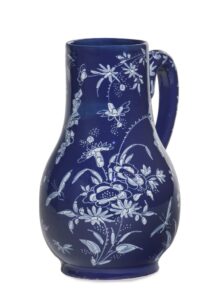
circa 1700, height: 21.5 cm. (8.5
in.), Aronson Collection inv. nr.
2414
Drinking was a central but controversial activity, taking place in homes, taverns, and during events such as weddings. Since the sixteenth century, the Dutch had been known for their excessive drinking habits, which even led the English to coin the phrase ‘Drinking in the Dutch Manner’ to describe heavy drinking.(13) Simultaneously, there was a widespread aversion to excess, including drinking, in seventeenth-century Dutch society, as evidenced by the symbolism found in paintings, literature, and poetry of the era. This sentiment towards drinking was eloquently expressed by the renowned Dutch poet Jacob Cats: “Suypen en vreten doet luttel weten,” which translates to “Drinking and eating excessively leaves little room for knowledge.”(14) To prevent overindulgence, some drinking vessels were decorated with educational and cautionary texts highlighting the dangers of excessive drinking and promoting moral integrity.(15)
Despite this, between 280 and 310 liters of ‘small beer’ (which had an alcohol content of circa 2%) per person were consumed in the Netherlands in the seventeenth century.(16) This vibrant culture must have spurred Delft potters to innovate various drinking tools to cater to customer demand.
Based on surviving examples, Delft potteries first produced tankards and jugs in response to the drinking culture. The models were based on German stoneware drinking vessels that were popular at the time. Contemporary paintings show the German jugs used for personal stock bottles, filled at a large tap barrel of an inn and poured by the customer into a glass.(17) Jugs with slimmer necks are depicted on paintings in connection to wine (fig. 1 and 2). Jugs or tankards with wider necks are believed to have been used for drinking beer directly (fig. 3 and 4).(18)
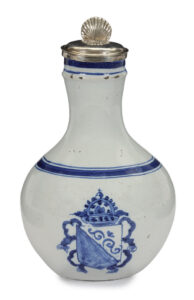
with Silver Cover, Aronson Collection
inv. nr D2401
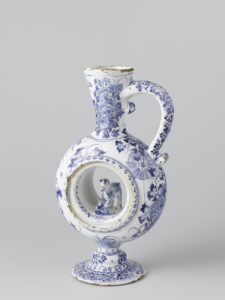
The desire for exotic objects soared after encountering Chinese porcelain and other items brought by the VOC (Dutch East India Company). Interestingly is that after the initial recognition of its ‘exotic’ origin, the specific source of the object seemed to matter less. The fact that Delft faience was commissioned by royals and the aristocracy and referred to as ‘Porcelain’ in inventories clearly indicates that Delftware was regarded as a suitable social statement.(19) The decoration on the vessels made in Delft could show both Chinese and Dutch elements, (fig. 10).(20) This gradual blending of imported and local styles ultimately gave rise to a completely new, distinctly Delft product.(21) But it had the ability to sustain the visual and functional expectations of an exotic piece.
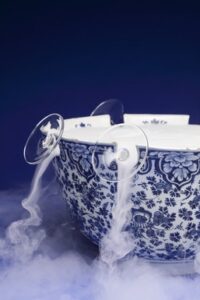
cm. (13.9 in.),Aronson Collection D2314
The popularity of this new type quickly surpassed that of the original German models.(22) A unique item showing the infusion of style elements is a jug with a hole in the middle, dated 1658 (Fig. 5). The date most likely indicates that it was made on commission. Whether it was used as a utilitarian or decorative object remains unknown.
Another example of a dated piece is an early Delft beer tankard from 1668, which skillfully combines the German stoneware model with typical Delft decoration inspired by both Chinese porcelain and Dutch floral still-life paintings (fig. 3). The continued popularity of this model is evidenced by a Persian Blue beer jug dating from around 1700 (Fig. 4). A jug with the coat of arms of Utrecht shows the variety in subjects (Fig. 6). This type of jug might have been used in the administrative circles of the city of Utrecht.
By 1650 there were more substitutes for beer and the overall consumption dropped. For example, in 1600, there were 82 breweries active in Delft; this number decreased to 27 by 1643 and further declined to just 8 between 1762 and 1768.(23) In the second half of the seventeenth century, gin slowly took over the role of beer, which made the Dutch republic a gin country.(24) However, this is not reflected in surviving Delft faience utilities for gin. Special gin bottles made of Delft earthenware did not exist in the seventeenth and eighteenth centuries. Most bottles used for storing gin or liqueur were typically made from glass.(25) Delft potters produced small liquor cups, evidenced by examples found in cesspits. There are few examples in museum collections, however, since utility wares were continually damaged during use.(26)
Wine consumption was less widespread than beer due to its high cost. As early as 1616, violent demonstrations erupted against increased grain taxation coupled with a simultaneous reduction in wine taxes, sparking accusations of class favoritism.(27) Eighteenth century French table customs also cemented the importance of wine amongst higher social circles.(28) The consumption of wine and liquor played a key role during dinners. Wine was chilled in ice-filled wine coolers, and wine glasses could be chilled in monteiths (fig. 7). Servants could rinse and refill wine glasses from a fountain on a buffet. Cisterns, akin to large tankards or small pitchers with a low spout for easy dispensing, typically held liquor. Delft potters transformed these utilitarian objects into delightful works of art, featuring a variety of designs from figural groups to mischievous monkeys, showcasing the versatility of Delftware designers. This ingenuity can be seen in figural cisterns portraying a man seated on a barrel or depicting men with their prosperous bellies (fig. 8).
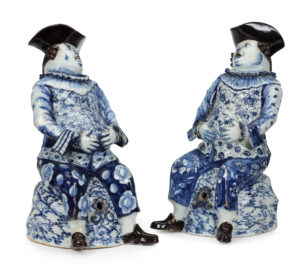
1760, Height: 34.5 cm. (13.6 in.), Aronson Collection
D2440
During the seventeenth and eighteenth centuries, puzzle jugs were popular. These intricate masterpieces were not intended for pouring or drinking like a typical jug or tankard, as evidenced by the pierced openwork on their necks. They served as playful or conversational items during dinner parties or for drinking games in taverns. The trick to solving the puzzle lies in the ingenious design of the jug (fig. 9 and fig. 10).
Delft potters proved their skills with creations like the ones described. The significance of Delftware is evident in various inventories, where only porcelain and Delftware were specifically mentioned by name. In contrast, other ceramic vessels were often categorized under generic terms like ‘pots and pans’ and, in the worst case, described as ‘rubbish’.(29)
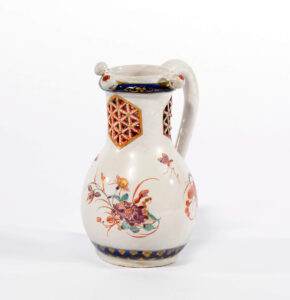
Puzzle Jug, Delft, circa 1730, Height: 19.6
cm. (7.7 in.), Aronson Collection D1618
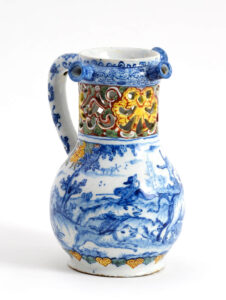
Delft, circa 1750, Height: 22.1
cm. (8.7 in.) Aronson Collection
D1838
In summary, the Delft pottery industry emerged on the foundations of the beer industry in the first half of the seventeenth century. This coincidental association with Dutch drinking culture evolved as potters produced special drinking utilities. The elite particularly showcased their refinement, humor, and hospitality with Delft faience. In this way, Delft potters not only contributed to the emerging Dutch identity but also became an integral part of it with what has become one of the Netherlands’ most famous national products.
NOTES
1. Hoelen, 1951, p. 33
2. Unger, 2001, p. 7
3. Unger 2001, p. 26 and p. 377
4. Dekken, 2009, p. 28 and p. 51
5. Van Oosten, 2015, p. 226, Finn, 2014, p. 72
6. Van Aken-Fehmers, 1999, p. 37
7. Dekken, 2009, p. 29
8. Van Aken-Fehmers, 1999, p. 37
9. Ariaans, 2020
10. Van Aken-Fehmers, 1999, p. 37
11. Idem.
12. Finn, 2014, p. 3
13. Finn, 2014, p. 49
14. Cats and Van Vloten, 1862, p. 942
15. Idem
16. Hoelen, 1951, p. 33
17. Van Hees, 2002, p. 49
18. Urbonaitė-Ubė, 2018, p. 192
19. Erkelens, 1996, p. 119
20. Van Dam, 2004, p. 39. For example, figure 10 shows a jug with Chinese symbols on the handle, combined with a European scene.
21. Finn, 2014, p. 242
22. Finn, 2014, p. 14
23. Unger, 2001, p. 223
24. Hoelen, 1951, p. 34
25. Klüver, 2023
26. Van Aken-Fehmers, 2003, p. 23
27. Finn, 2015, p. 231
29. Hoelen, 1951, p. 35
29. Finn, 2014, p. 313
LITERATURE
Ariaans, Céline, ‘Delft in de zeventiende en achttiende eeuw’, published on: www.delftsaardewerk.nl
Aken-Fehmers, Marion S. van, ‘Delfts Aardewerk: Geschiedenis van een Nationaal Product’, Zwolle, 1999
Cats, Jacob, J. van Vloten, ‘Alle Wercken van Jacob Cats, Deel I’, 1862
Dekken, Marjolein van, ‘Brewing, distilling and serving: Working women in Dutch drink industry, 1500-1800′, 2009
Erkelens, A.M.L.E., ‘Queen Marys’ ‘Delft Porcelain’, Zwolle, 1996
Finn, Claire P., ‘The Material Culture of Drinking and the Construction of Social Identities in the Seventeenth-Century Dutch Republic Volume I’, Thesis submitted for the degree of Doctor of Philosophy Department of Archaeology, The University of Sheffield, September 2014
Hees, Christel van, ‘Baardmannen en puntneuzen. Vorm, gebruik en betekenis van gezichtskruiken 1500-1700’, Zwolle, 2002
Hoelen, H., ‘Drinkgewoonten in de Lage Landen in de loop der Tijden‘, in: ‘Vijftiende Jaarboekje van het Nationaal Comite voor Brouwersgerst’, 1951
Klüver, Suzanne, ‘Schiedamse jenever en Delfts blauw’, published on Delftsaardewerk.nl, 2023
Oosten, Roos van, ‘De stad, het vuil en de beerput. De opkomst, verbreding en neergang van de beerput in stedelijke context’, Leiden, 2015
Unger, Richard W., ‘A History of Brewing Beer in Holland 900-1900: Economy, Technology and the State’, Leiden, Boston, Köln, 2001



